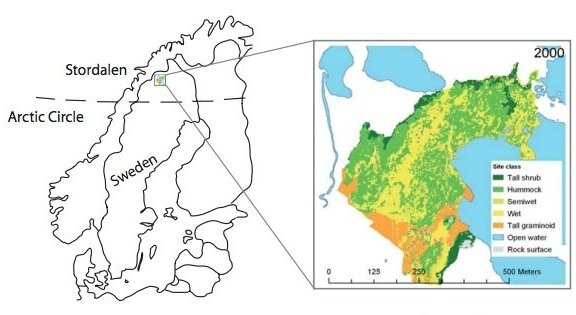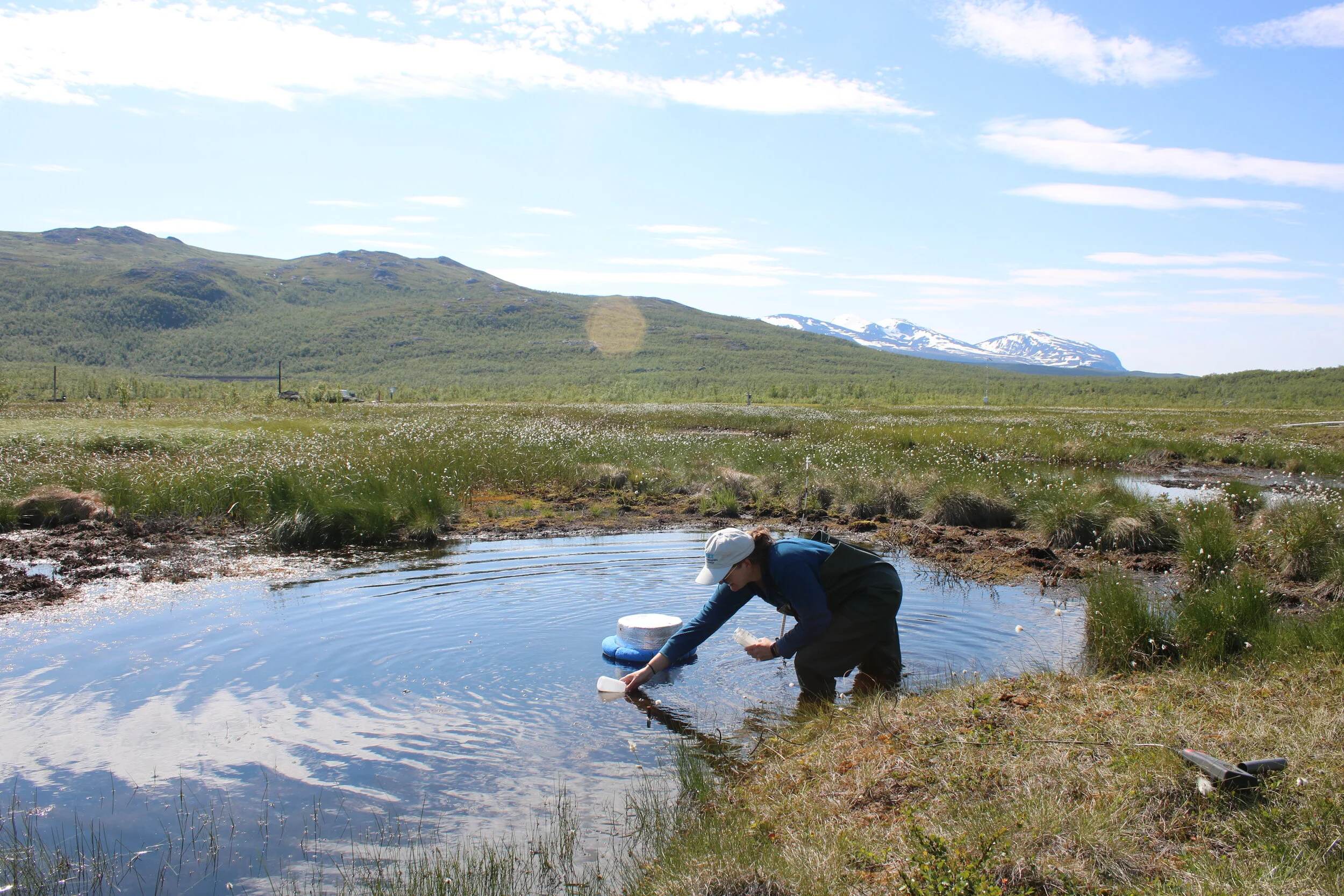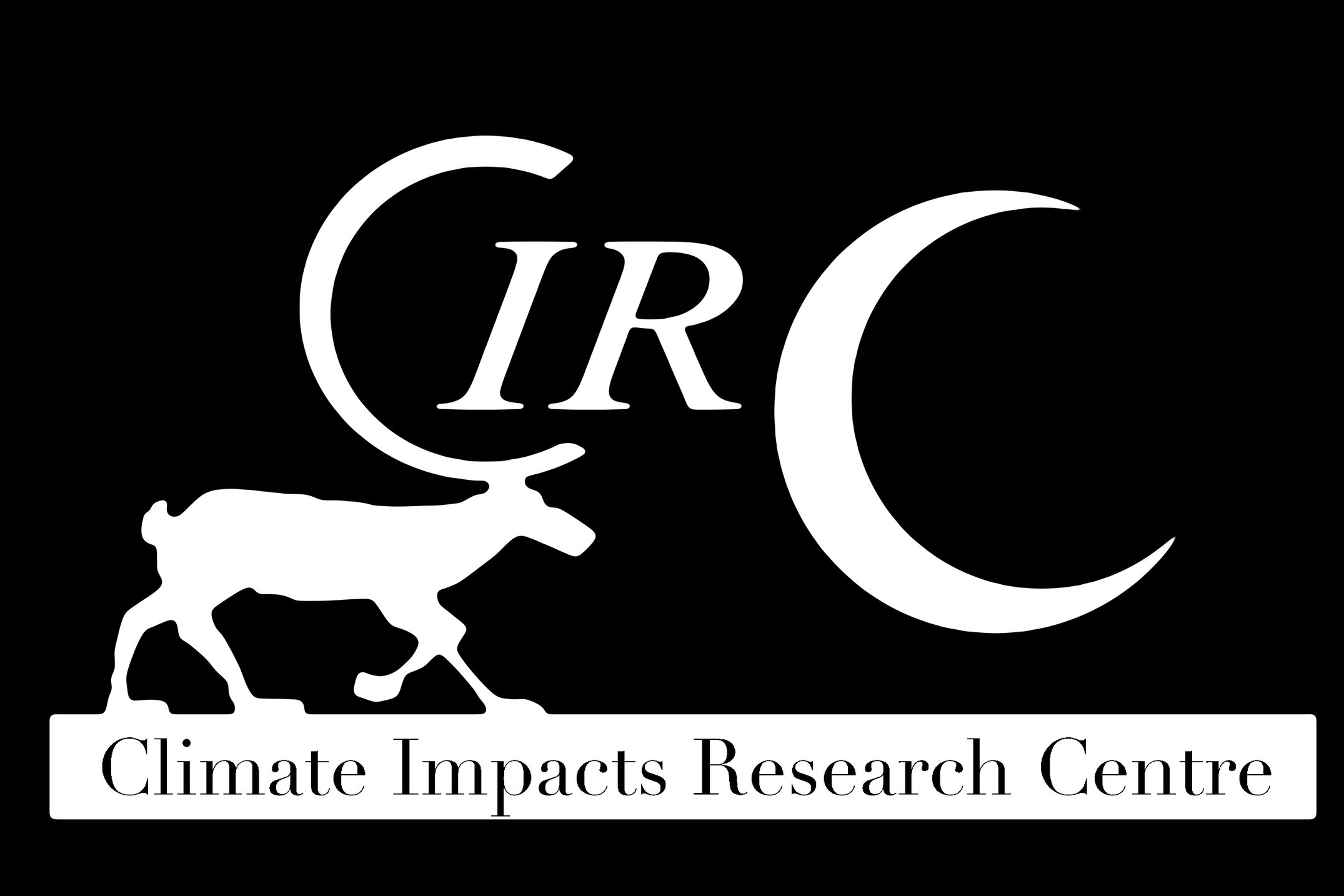Stordalen Mire
A palsa permafrost mire and lake system with climate and vegetation research reaching back to the 1970’s
68.20°N, 19.03°E, 351m above sea level
Map
My Google Maps Demo
About Stordalen
Stordalen mire is the subarctic region located about 10 km southeast of the Abisko Scientific Research Station and ten meters above Lake Tornetrask. The mire is in the discontinuous permafrost zone, encompassing a mosaic of thaw stages with associated distinct hydrology and vegetation, microbiota, and organic matter chemistry.
It is made up of four major habitats: (1) elevated, nutrient-deficient (ombrotrophic) areas with hummocks and small shallow depressions; (2) wet, nutrient-richer (minerotrophic) depressions; (3) pools and (4) brooks.
Stordalen mire is characterized by three land cover types: palsa, sphagnum, and eriophorum, respectively. The topography in Stordalen is characterized by a gradient from high elevation (≈800 m.a.s.l.) in the southern part to low lying topography (≈360 m.a.s.l.) in the north. The upper (southern) catchment has steep slopes consisting of igneous and metamorphic rock outcrops and tundra, with patchy lakes and mires. Lower catchment streams are dispersed and drain into larger lower lying lakes. The inflection point of the catchment is marked by birch forest (Betula pubescens spp) and further towards the north, by the emergence of mires and lakes.
The permafrost at Stordalen is thawing, and this thaw is altering habitats and plant and microbial communities. According to vegetation surveys and analyses of aerial photographs taken at Stordalen, permafrost thaw between 1970 and 2000 has caused dry permafrost hummocks to decrease in area by 10%, giving way to wetter minerotrophic sites, which increased by 17%. These changes have been accompanied by shifts in plant community from shrubs and lichens in permafrost hummocks to Sphagnum spp. in wetter sites followed by evolution to tall graminoid species as thaw-induced subsidence increases.[1]
Stordalen Mire was part of the International Biological Programme and has been of environmental research interest for several decades.
The mire is in the discontinuous permafrost zone. Peat depth is 1-3 m and permafrost is usually found at depths below 0.5-1 m. The soil is organic, with 99% organic matter content. As a result of recent years warming in the area, permafrost has been observed to degrade in many parts of the mires. The permafrost thaw is altering habitats and plant and microbial communities. The extent of the wetland vegetation has grown considerably, and methane emissions have increased.
Data is available on plant community, permafrost distribution and carbon flux dynamics since the 1970s.
The site hosts an ICOS ecosystem station. Besides standard ICOS measurements (primarily data on greenhouse gas concentrations and fluxes, latent and sensible heat fluxes, meteorological and soil parameters), laughing gas N2O flux measurements, as an example, are carried out at the site.
Site Established: Early 1970’s
Research Projects
The study of the ecological impacts of permafrost degradation
Microbial ecology
Soil viromics
Carbon cycling
Methane flux
Projects
Influence of vegetation on net ecosystem carbon balance in subarctic mire thaw
This project investigates how primary producer community composition and functional characteristics of primary producer species influence the net ecosystem carbon balance of permafrost thaw ponds.
Data Collected
Data collected at Stordalen is primarily data on greenhouse gas concentrations and fluxes, as well as latent and sensible heat fluxes. In addition: several meteorological and soil parameters.
Available Instruments & Infrastructure
Descriptions of instruments in the field collecting data, e.g. climate stations, flux towers, etc.
Principal Investigators
Meet the PI's working on projects at the Nuolja Field Site (use field site name tags in a summary block)
Collaborators
list of hyperlinked collaborators on projects at this site
Funders
Note: we get a Funders page set up later, this can be a summary widget displaying funder blog posts tagged to this field site.
Funder name, hyperlinked
Stordalen Field Site Photo Gallery












Stordalen in the News
The work of researchers in Stordalen was recently featured in two episode of our podcast, Field Notes on Climate Change. The first, ‘Methane-burping Lakes,’ explores dissolved carbon dioxide and methane transfer into the air from surface water and how that varies with different vegetation in lakes, and ebullition - the bubbles of methane produced by microbes in lakes. The second, ‘Copepods,’ explores the growth rates of copepods in ponds with differing vegetation to understand how they react to an increase in organic matter, which is likely to occur with climate change.
Listen to the episodes using the player below, or find the podcast on iTunes, Stitcher and Acast.
Articles
Myren ger svar på jordens hälsa (The ant gives answers to the health of the earth), Sydsvenskan, 2008
Klimatförändringarna får kalfjället att växa igen (Climate change causes the scales to grow again), Sveriges Natur ,2017
Permafrosten kan snart vara ett minne blott (The permafrost may soon be just a memory), Gefle Dagblad, 2008
Illustrations



Publications
Explore publications associated with Stordalen Mire.
Chang, KY, Riley, WJ, Brodie, EL, McCalley, CK, Crill, PM, Grant, RF (2019) Methane Production Pathway Regulated Proximally by Substrate Availability and Distally by Temperature in a High-Latitude Mire Complex. JGR: Biogeosciences 124 (10): 3057-3074. DOI: 10.1029/2019JG005355
Chang, KY, Riley, WJ, Crill, PM, Grant, RF, Rich, VI, and Saleska, S. R.(2019) Large carbon cycle sensitivities to climate across a permafrost thaw gradient in subarctic Sweden. The Cryosphere 13: 647-663. DOI: 10.5194/tc-13-647-2019
Martinez, Miguel A.; Woodcroft, Ben J.; Espinoza, Julio C. Ignacio; et al. Group Author(s): IsoGenie Project Coordinators (2019) Discovery and ecogenomic context of a global Caldiserica-related phylum active in thawing permafrost, Candidatus Cryosericota phylum nov., Ca. Cryosericia class nov., Ca. Cryosericales ord. nov., Ca. Cryosericaceae fam. nov., comprising the four species Cryosericum septentrionale gen. nov. sp. nov., Ca. C. hinesii sp. nov., Ca. C. odellii sp. nov., Ca. C. terrychapinii sp. nov. Systematic and Applied Microbiology 42 (1): 54-66. DOI: 10.1016/j.syapm.2018.12.003
2018 ...
Malhotra, A, Moore, TR, Limpens, J and Roulet, NT (2018) Post-thaw variability in litter decomposition best explained by microtopography at an icerich permafrost peatland. Arctic, Antarctic, and Alpine Research, 50:1, e1415622, DOI: 10.1080/15230430.2017.1415622
Mzobe P, Berggren M, Pilesjo P, Lundin E, Olefeldt D, Roulet NT, et al. (2018) Dissolved organic carbon in streams within a subarctic catchment analysed using a GIS/remote sensing approach. PLoS ONE 13(7): e0199608. DOI: 10.1371/journal.pone.0199608
Palace, M, et al (2018) Determining Subarctic Peatland Vegetation Using an Unmanned Aerial System (UAS). Remote Sensing 10 (9), 1498. DOI: 10.3390/rs10091498
Pokrovsky, OS, Karlsson, J, Giesler, R (2018) Freeze-thaw cycles of Arctic thaw ponds remove colloidal metals and generate low-molecular-weight organic matter. Biogeochemistry 137 (3): 321-336. DOI:10.1007/s10533-018-0421-6
Singleton, Caitlin M.; McCalley, Carmody K.; Woodcroft, Ben J.; et al. (2018) Methanotrophy across a natural permafrost thaw environment. ISME Journal 12 (10): 2544-2558. DOI: 10.1038/s41396-018-0065-5
Trubl G, Jang HB, Roux S, Emerson JB, Solonenko N, Vik DR, Solden L, Ellenbogen J, Runyon AT, Bolduc B, Woodcroft BJ, Saleska SR, Tyson GW, Wrighton KC, Sullivan MB, Rich VI.(2018) Soil viruses are underexplored players in ecosystem carbon processing. mSystems 3:e00076-18. DOI: 10.1128/ mSystems.00076-18
2017
Galka, M, et al (2017) Vegetation Succession, Carbon Accumulation and Hydrological Change in Subarctic Peatlands, Abisko, Northern Sweden. Permafrost and Periglacial Processes 28 (4): 589-604 DOI: 10.1002/ppp.1945
Kruger, J.P., Conen, F., Leifeld, J., Alewell, C (2017) Palsa Uplift Identified by Stable Isotope Depth Profiles and Relation of N-15 to C/N Ratio. Permafrost and Periglacial Processes 28 (2): 485-492. DOI: 10.1002/ppp.1936
2016
Hodgkins, SB, et al (2016) Elemental composition and optical properties reveal changes in dissolved organic matter along a permafrost thaw chronosequence in a subarctic peatland. Geochimica et Cosmochimica Acta 187: 123-140 DOI: 10.1016/j.gca.2016.05.015
2015
Thompson, MS, Giesler, R, Karlsson, J, Klaminder, J (2015) Size and characteristics of the DOC pool in near-surface subarctic mire permafrost as a potential source for nearby freshwaters. Arctic, Antarctic and Alpine Research 47 (1): 49-58. DOI: 10.1657/AAAR0014-010
2014
Hodgkins, S.B., et al (2014) Changes in peat chemistry associated with permafrost thaw increase greenhouse gas production. Proceedings of the National Academy of Sciences of the United States of America 111 (16): 5819-5824 DOI: 10.1073/pnas.1314641111
2011
Alewell, C, Giesler, R, Klaminder, J, Leifeld, J, Rollog, M (2011) Stable carbon isotopes as indicators for environmental change in palsa peats. Biogeosciences 8 (7): 1769-1778. DOI: 10.5194/bg-8-1769-2011
2010
Bäckstrand, K., Crill, P. M., Jackowicz-Korczyñski, M., Mastepanov, M., Christensen, T. R., and Bastviken, D. (2010) Annual carbon gas budget for a subarctic peatland, Northern Sweden, Biogeosciences 7: 95–108. DOI: 10.5194/bg-7-95-2010
Kammermann, L., M. Gysel, E. Weingartner, H. Herich, D. J. Cziczo, T. Holst, B. Svenningsson, A. Arneth, and U. Baltensperger (2010) Subarctic atmospheric aerosol composition: 3. Measured and modeled properties of cloud condensation nuclei. Journal of Geophysical Research 115, D04202, DOI: 10.1029/2009JD012447
2008
Petrescu, A.M.R, et al (2008) Modelling CH4 emissions from arctic wetlands: effects of hydrological parameterization. Biogeosciences 5 (1): 111-121. DOI: 10.5194/bg-5-111-2008







